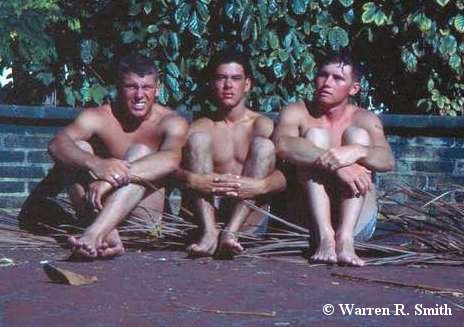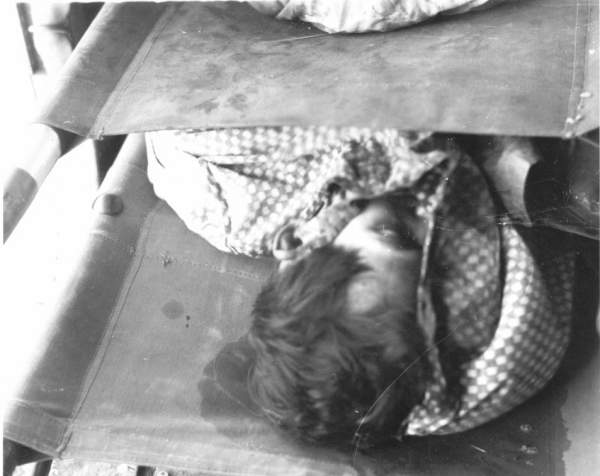
Cpl. Warren R. Smith

Cpl. Warren R. Smith
On May 31, 1964 we were flying southwest again heading for a Special Forces camp that suffered 28 casualties the night before. It was the first flight of the morning and we were safe at the 2000’ plus altitude. The outside temperature was pulling that flight line heat out of the planes and we were feeling more comfortable all the time. As the engine droned on, I reflected on that first mission I had flown in this area a few short months ago when I thought I had been wounded. I was a lot more confident, knew where the hot spots were, and when to start the adrenaline flowing. This was a time to relax and allow your mind to take a break.
It was such a beautiful day. The sky surrounded us with a bright, dark blue broken with a few cotton ball clouds and an overpowering, tranquil, green, countryside slide along below. It was Sunday morning and I was thinking of my parents, brother, and sister all walking down the hill back in Lafayette, Indiana on their way to church. It is also lush this time of year in Indiana and the heat and humidity makes sitting in church a penance from this point on. What a long ways I was from there on the other side of the world. I was in a UH-34D on my way to war and they were on their way to church to praise God.
All to soon the outpost came into view and it looked like so many others that we supplied with our aerial service. It was a light dusty brown in the middle of a sea of green. It was ringed with multiple strands of barbed wire mosaics followed by open shooting fields, sandbagged shooting pits covered with tin and ponchos, with a major block house and miscellaneous huts in the center. As we circled, I could hear the pilots in communication with the American advisors on the ground. It was always easier to work with an outpost that had both a radio with the right frequencies, identified beforehand, and an English-speaking transmitter. We were given the correct approach to an open area in the center of this small fort. I could see our cargo lined up in rows next to the landing area. There were bundles with different wrappings of blankets and ponchos. Some of them had boots sticking out of the ends of the packages. We got the story when we landed.
The night before a couple of patrols were going out at dusk when a sniper fired one round at them. There was a panic and they all started to run for cover. Explosions were following them as they tried to escape. Everywhere they looked there were bodies that fueled increased panic. It was all over in a flash, 24 Vietnamese troops had ended their lives in the middle of their own minefield, driven to their death by one sniper round. A proud VC surely got a medal that evening.
The killing wasn't over yet. The Special Forces advisors dispatched help to assist those still dying and within a short time 4 more Vietnamese had blown themselves up. The body count was now up to 28 and all in the VC favor. It was then decided to wait for the morning light to remove the bodies. The Special Forces team went into the minefield the next morning and retrieved all the casualties without further incident. Looking down from above, the way the stretchers were lined up, it looked like a reclined formation to greet us.
Our planes either had the troop seats folded up to the wall or had them taken out to keep troops from using them as a hand holds when they didn't want to leave the chopper. It was easier to use the bare floor for cargo, troops, and casualties especially when cleaning up afterwards. Soon after landing and being briefed on the situation, the advisors started teams of stretcher-bearers moving the bodies to the planes. LCpl. Henderson and I were not sure how we were going to handle this cargo, but as soon as he had the stretcher into the plane we rolled the body on the floor and handed the stretcher back out the door. We wanted to conserve as much space as possible for the rest of the patrol. Immediately, all hell broke loose from the Vietnamese, as they didn't want us to pile the bodies on top of each other. It was requested that we rig litter straps to separate the stretchers, but this would take out Henderson’s gun position and I don't think we had the litter straps anyway. We compromised on leaving the bodies on the stretchers and being careful as to not lay the poles across anyone's face. We did the best we could, as some of the packages didn't have feet from contact with the mines, and it was hard to tell which end was which. We put one forward port side and one aft starboard side and then interlaced them between the two piles to keep them from falling over. I can't remember how many planes we had along, but this was a trip we didn't want to have to do again. We filled our planes with these fallen warriors, took off, and headed for Da Nang as fast as we could. The wind blowing in the door was not a relief now. It blew the coverings from these young men and Larry and I had to look at the horrors of mine warfare all the way home. Instead of my mind slipping into the beauty of the countryside, my thoughts were of rabbit hunting in Indiana. The smell from the packages was the same sensory memory I had of fresh killed rabbits in my shooting jacket.
The trip back seemed to take a lot longer than that coming down and I didn't feel much like praising God on this day.
 |
 |
|
|
|
Years later Kris Kristoferson (sp), the song writer and questionable singer wrote a song " Sunday Morning Coming Down" It was about a young man at the opposite end of Sunday morning. He was living the bad part, but his senses were picking up all the signals that reminded him of the good parts. I always remember that 31st day of May 1964 when I hear the song.
Submitted by:
Warren R. Smith, former Cpl. USMC